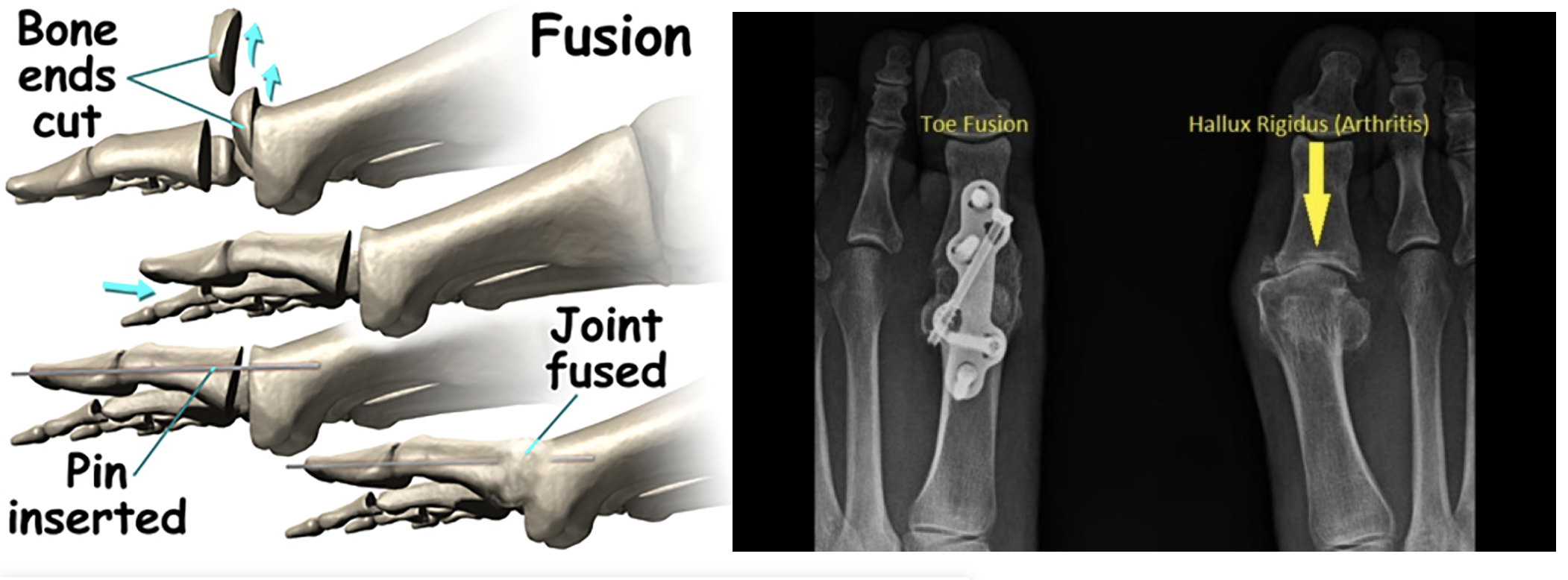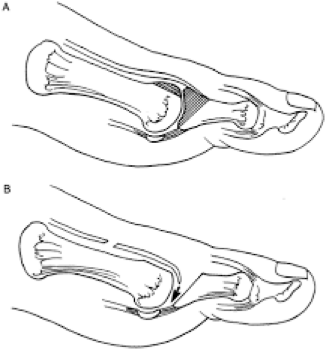
What is hallux rigidus?
Hallux rigidus or dorsal bunion is a disorder of the joint located at the base of the big toe. It causes swelling, pain and stiffness of the joint. Since this joint is involved in all activities of daily living like walking, climbing or stooping down, it can be quite disabling.
What are the causes of Hallux rigidus?
Hallux rigidus occurs due to faulty function (biomechanics) of the joint at the base of the big toe or structural abnormalities of the foot which lead to osteoarthritis of the big toe joint.
♦Trauma- This is the most common cause. This can be a single episode of injury causing damage to the ligaments around the joint and leading to abnormal loading of the joint or repetitive episodes of microtrauma leading to degenerative arthritis.
♦Heredity- Hallux rigidus may run in families as a result of inheriting a particular foot type or shape. It may be seen in both feet in patients with familial inheritance.
♦Overuse- Patients involved in activities of overuse of big toe like repeated standing or squatting are prone.
♦Inflammatory conditions- Patients with inflammatory conditions like rheumatoid arthritis, gout or seronegative arthritis are equally prone.
♦Other causes- like long first ray of foot, flat feet, female gender or flat joint surfaces of the big toe joint may also be implicated.

What are the symptoms of hallux rigidus?
Early symptoms include: -
♦Swelling around the joint.
♦Pain and stiffness of big toe in walking and bending forward.
♦Difficulty in running and squatting.
Late symptoms: -
As the disease progresses one experiences
♦ Pain even at rest.
♦Difficulty in wearing shoes due to bony bump on the upper surfaces of the joint.
♦Limping.
♦Pain in hip, knee and lower back due to disturbance in walking pattern or gait.
Diagnosis
It is best to see a foot and ankle surgeon when you first experience the early signs of the disease. Waiting for the symptoms to worsen or until the bony bump appears, makes the condition more difficult to treat. The foot and ankle surgeon will examine your feet both in sitting and standing positions as well as evaluate your gait. He will also check for movements of your great toe and first Ray. X rays will be ordered to see for the severity of the joint arthritis and bony spurs at the involved joint.
Treatment:
Non-surgical treatment: -
Medications: - Oral non-steroidal anti-inflammatory drugs (NSAIDS) may be helpful in reducing pain and inflammation in the early stages.

Orthotic devices or insoles: -
Customised orthotic devices to stiffen the shank of the shoe especially the area of the big toe and deepen the heel cup can help decrease moments at the painful joint and offload the joint.

Shoe modifications:-
Shoes with a roomy toe box tends to decrease pressure on the bump on the upper surface of the big toe. Stiff soled and rocker bottom shoes also help to relieve pain by decreasing movements at the involved joint.
Injection therapy:-
Steroid or Hyaluronic acid injections into the big toe joint can also help to provide relief.
When is surgery required?
In certain cases, surgery is the only way to reduce or eliminate pain. Several types of surgeries are available for treatment of hallux rigidus. In deciding the type of procedure or combination of procedures for your foot, the foot and ankle surgeon will take into consideration numerous factors such as age and activity level of the patient, the severity of arthritis on X rays, flexibility of the big toe and foot joints in sitting and standing positions, length and elevation of the medial ray of the foot, etc among a host of other factors. Some of the surgical procedures undertaken include: -

1- Cheilectomy: -
This is recommended when the deformity is mild to moderate. This involves removing the bony spur on top of the big toe so that it has more room to move up. The incision for the same is made on top of the toe and the spur along with part of the articular surface is removed. The patient is asked to wear an open stiff soled sandal for 2 weeks after the procedure and allowed to walk the very next day. The toe may remain swollen for a few months after surgery which is relieved by keeping the leg elevated when not walking. Stitches are removed in 10 to 14 days and most patients experience long-term relief.
2-Arthrodesis of joint: -

When the damage to the cartilage is severe and it is not possible to save the joint, the damaged cartilage is removed and the joint is fixed in a permanent position with screws plates for pins. The fusion of the damaged joint helps to relieve the pain in severe cases. For the first 6 weeks following this procedure you may have to wear forefoot offloading footwear or walk on the outer border of your foot. This procedure provides permanent relief of the pain in the long term.
3- Osteotomy of the first ray or toe: -
In cases when the first ray is long or elevated, movements of the big toe may be hindered. In such cases shortening of the long first ray or depressing the first ray helps to improve the joint motion. This may be combined with the release of the tight calf muscles or tendons in the arch of the foot. Following this procedure, you may be asked to offload the foot for the first 6-8 weeks after surgery till the bone unites.
4- Arthroplasty of the big toe: -
In certain older individuals with severe arthritis in the big toe and low functional demands on the feet, the joints surfaces are removed and rolled up tendon is inserted as a ‘spacer’ in between the joint surfaces or an artificial joint is implanted. This procedure relieves the pain and preserve joint motion.

Can Hallux rigidus be prevented?
While there is no definite way to prevent hallux rigidus, you can slow its progression by doing exercises to keep the joint mobile, resting it when it becomes painful and wearing good fitting shoes with enough space around the toes to facilitate movement. If your toe becomes stiff and painful, early diagnosis and treatment can ensure a successful treatment.

